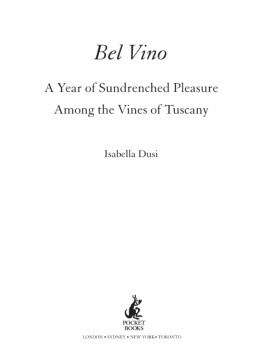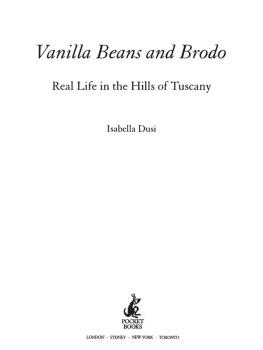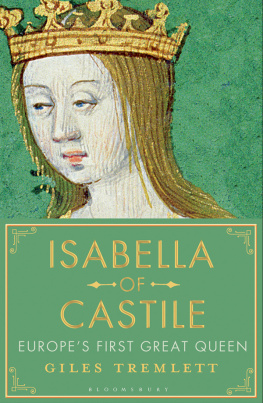Praise for Vanilla Beans & Brodo
The subtitle of Vanilla Beans & Brodo is Real Life in the Hills of Tuscany and it jolly well is. She actually describes the village in magnificent terms and it makes me want to go there Simon Calder, Independent
Another tale of outsiders making a new life in Italy would need to be something special. Luckily, Isabella Dusis account of her acceptance of the proud, warm-hearted natives... is absolutely captivating Irish Times
Full of the passions and pleasures of life in the midst of a warmhearted and proudly independent community in the Tuscan hills Daily Express
Enticing The Times
Communicates well the rhythm of time-honoured activities in a close-knit community, which, over the centuries, has defended itself against the Florentines, Sienese, Spanish and French Sunday Times
Dusis account of her assimilation into the customs, people and food of her new home in Tuscany is the stuff of daydreams Woman & Home
Dusi does far more for Tuscany than Peter Mayle did for Provence in her fascinating look at day-to-day life in the Italian hills Lancashire Evening Post
Deeply satisfying Doncaster Star
Dusi tells the story of twelve months in this remarkable world, and does so with such evocative and glowing prose that she transports the reader to her new found home Wigan Evening Post
It is, without doubt, a joy Dorset Echo
About the Author
After many years working in Australia in interior design, Isabella Dusi decided to move to Italy with her husband Luigi. Living permanently in Montalcino, they now work in the travel business. She is also the author of Vanilla Beans & Brodo.

First published in Great Britain by Pocket, 2004
An imprint of Simon & Schuster UK Ltd
A CBS COMPANY
Copyright Isabella Dusi, 2004
Illustrations copyright Barbara Horne, 2004.
This book is copyright under the Berne Convention
No reproduction without permission
and Simon & Schuster Inc. All rights reserved
Pocket & Design is a registered trademark of Simon & Schuster Inc.
The right of Isabella Dusi to be identified as the author of this work has been asserted in accordance with sections 77 and 78 of the Copyright, Designs and Patents Act, 1988.
Simon & Schuster UK Ltd
1st Floor
222 Grays Inn Road
London
WC1X 8HB
www.simonandschuster.co.uk
Simon & Schuster Australia, Sydney
Simon & Schuster India, New Delhi
A CIP catalogue record for this book is available from the British Library
ISBN: 978-0-74347-844-1
eBook ISBN: 978-1-47113-482-1
Typeset by SX Composing DTP, Rayleigh, Essex
Printed in Great Britain by
Cox & Wyman Limited, Reading, Berkshire
To my grandchildren
Brodie John and Breanna Jade
Illustrations
Acknowledgements and Sources
The Ingegnere, Signor Guido Padelletti
Signora Francesca Colombini Cinelli
Signor Andrea Costanti
Signor John and Signora Pamela Mariani
Mayor Massimo Ferretti
Anderson, Burton, Biondi Santi, Union Design
Biondi Santi, Franco, Il Brunello di Montalcino, il Passato ed il Futuro, F. Biondi Santi
Bonucci, Bruno, Montalcino Pietre e Storia, Editrice Donchisciotte Il Sammichele di Castiglione del Bosco, La Piazza
The Brothers of the Abbey of Sant Antimo, A Stone That Sings, Edizioni Cantagalli
Caprioli, Ivo, Diecimila Anni di Vita, Grafica La Proposta, Montalcino
Caprioli, Ivo and Francesco Pescatori, Artigianato: Commercio e Attivita Diverse nel Borghetto, Grafica La Proposta, Montalcino
Carle, Lucia, La Patria Locale, Regione Toscana, Giunta Regionale
Christie, Neil, The Lombards, Blackwell Publishers
Mantaut, Elena, Citta Murate del Veneto, BellItalia
Raffaelli, Ilio, Montalcino... Collina dItalia, Type Service Editore, Massa
Creativita Popolare Montalcinesi, Nencini Editore
CHAPTER ONE

The Monks Sandals
Following the contours of the wooded crag the pebbly track curves downwards, then climbs steadily into oak woods. An hour crossing from hill to hill drifts into two. My knees adjust to the hilly terrain, and my mind is soothed by the silence in this shadowy oak coppice. For the first kilometre or two I have skirted ranks of vines surrounding stone farmhouses and stepped stealthily along a rocky track, hoping not to rouse sleeping dogs. Then a pack of three, sensing my intrusion, erupts from a barn and races towards me, baying in a frenzy at my boldness as I hurry along the flanks of their vineyard. Nothing stirs in the farmhouse. Nor from the shuttered windows further on where other dogs, alerted by the barking back along the track, lie in wait, heads raised and ears at full cock. Beside a paddock of grazing horses the track dog-legs into a thicket before sinking into a dark glade, giving me a last glimpse of the bell towers above a walled Tuscan village strung along the ridge. Montalcino, my home.
My eyes at last accustomed to the dappled light, I pick my way along the eroded bed of a ditch where a trickle of water ripples over stones and mossy logs. I suspect I have hastened to follow this remote track too early in the season. Stooping to inspect fresh droppings beside the water, I gaze at animal tracks in the mud the hoofs of a wild boar that has still to retreat into the dense underbrush for the mating season. Hoping this Tuscan cinghiale is as reluctant to show itself as I am to confront it, I quicken my pace and do not look back until the track rises abruptly from the glade and takes me into an oak coppice where small birds swoop skittishly about, diving among the branches, twittering one to the other, confidence sky high.
I work my way through scree and up to a rounded hill crowned with tall pines. At last the underbrush thins and I breathe in the evocative smell of damp earth and pine needles. Bursting suddenly into view, an abbey sits in a gloomy valley where woods and undergrowth give way to green meadows. The sun has not yet touched the abbey, which pleases me, because my arrival before the sun promises that my lonely dawn start will not be unrewarded. I follow the downward path and plough into the woods, shut in close by hills once more; shadows deepen as the track descends.
After a couple of silent hours trekking through the Tuscan hills with little but encounters of this nature and my thoughts for company, Im almost sorry that in a few hundred metres the track peters out. Walking between ear-flicking and unfettered cattle, their breath steaming in the morning air, I hurry across the meadow towards the Abbey of Sant Antimo, nestled pale in the Valley of Starcia.
Certain that the abbey doors will be open at first light, I dont intend to delay my entry, but I halt mid-stride to capture an overwhelming moment. Reaching into the sky, the abbey is a visible layering of architectural signatures through the centuries, yet there is a harmony to the whole that unites the hand of the architect to the wilderness of the valley.
I scan the abbey grounds, straining to hear the human sounds penetrating the stillness. Where the glory of God is sanctified, his Tuscan servants thought to plant an olive grove. Four wooden ladders are wedged in the branches of an olive tree. Chatting monks are visible from the knees down; white gowns flap around their ankles but their shapes are immersed in foliage. It is a quick exchange; words cease and work resumes. Strapped sandals, the sight of which make me smile, offer their feet no purchase on worn rungs. The monk nearest me rocks back and forth as he saws, causing his heels to drop over the back of the rung and then push forward, sinking his toes into hollows in the leather as his sandals buckle and bend under the strain. A cloaked arm pushes a cut branch into the air and it thumps to the ground. Four monks in one olive tree; one slices with a machete, one supports a doomed branch, one saws at the heart of the tree and the fourth reaches out and drops the pruned branch to the grass. Hessian sacks, bulging with twigs and leaves and knotted roughly at the neck with a length of rope, lean against a tree which has been pruned this morning. In orderly groves the trees follow one another in lines over the hill, each tree a precisely calculated distance from its neighbour. But these olive trees were planted across the abbey grounds at random centuries ago, their purpose as much to provide tethering points for vines as to pick and crush olives for the abbeys oil-burning lamps. Gnarled trunks contort and twist; it is as if each tree has agonized about the direction in which to grow. High among the branches where the monks are at work spring growth is at a spurt and wispy tendrils bear double-fronted grey-green leaves. More than one of these olive trees has stood here for a thousand years.
Next page









